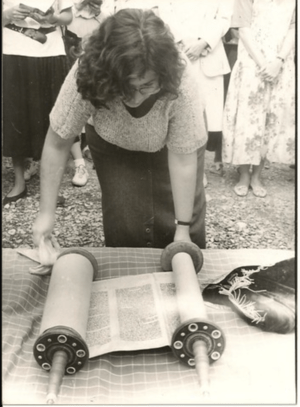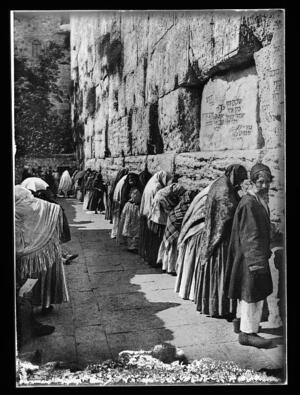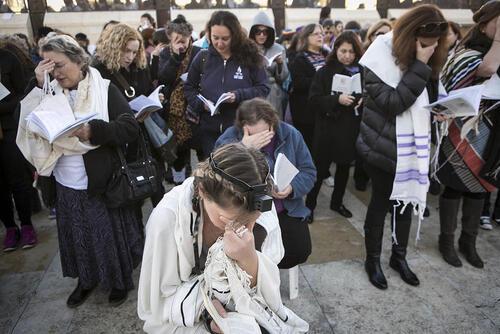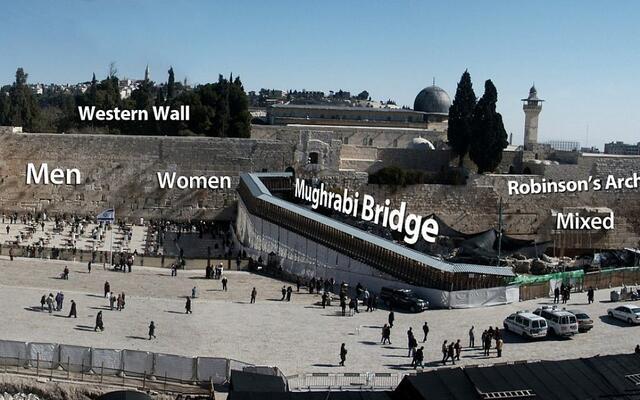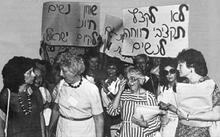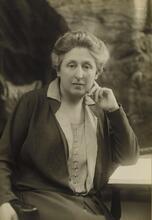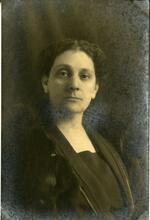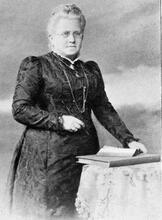Women of the Wall
Courtesy of Joan Roth.
Women of the Wall (WOW) is an international community of women who, since 1988, have sought the freedom to conduct women-led Torah services in the women’s section at the Western Wall in Jerusalem. The group has been at the center of a controversy raises several complex issues. Its legal claims and political strategies raise questions about women’s rights to equality within Judaism and under Israeli law, the nature of religious toleration for non-Orthodox Jewish movements, and Israel’s identity as a Jewish and democratic state. The decades of violent opposition to WOW highlights the role of tradition and patriarchy at the heart of Jewish nationhood, but WOW’s success in turning around Israeli public opinion, winning international support, and succeeding in court has expanded the horizon for religious feminism.
For over three decades, Women of the Wall (WOW), a group of women who assert their right to pray in the manner they see fit in the women’s section of the Western Wall in Jerusalem, has been at the center of a controversy that engages many complex issues. Their legal claims and political strategies raise questions about women’s rights to equality within Judaism and under the laws of the Israeli state, the nature of religious toleration for non-Orthodox movements within Judaism, and Israel’s identity as a Jewish and democratic state. The outcome of this dispute, which remains uncertain, is important not only for the Women of the Wall themselves, but also for the future of human rights in Israel.
WOW’s Origins in the International Jewish Feminism Movement
The story of Women of the Wall began in 1988, when women from around the world attended the First International Jewish Feminist Conference in Jerusalem. On the final day of the conference, Rivka Haut, one of the founders of the Orthodox women’s tefillah movement in the United States, invited participants to attend a women-led “gratitude prayer for the wellbeing of the state of Israel” at the Western Wall. Sixty women, who identified with a range of movements within Judaism, accepted the invitation.
In order to meet the needs of this diverse group of women, WOW created a hybrid mode of worship that mixed Orthodox norms with practices of the Reform and Conservative movements. The women prayed in single-sex groups, in the women’s section, and did not include parts of the service that require the presence of a The quorum, traditionally of ten adult males over the age of thirteen, required for public synagogue service and several other religious ceremonies.minyan of ten men. Over time, their practice grew to include wearing Four-cornered prayer shawl with fringes (zizit) at each corner.tallit, donning Phylacteriestefillin, and reading from the Torah she-bi-khetav: Lit. "the written Torah." The Bible; the Pentateuch; Tanakh (the Pentateuch, Prophets and Hagiographia)Torah. While this mode of prayer has the approval of some Orthodox authorities, it is controversial for a number of reasons. Women raising their voices in collective prayer, rather than praying quietly as individuals, is seen as impairing the ability of men to pray, as they may be distracted by the erotic voices of women (kol isha). Women conducting their own service, reading from and handling the Torah, is seen as a provocative violation of traditional gender roles relating to the exemption of women from the performance of positive time-bound commandments (mitzvot aseh she-ha-zeman geraman). While The legal corpus of Jewish laws and observances as prescribed in the Torah and interpreted by rabbinic authorities, beginning with those of the Mishnah and Talmud.halakhic experts for the Women of the Wall conclude that women may wear prayer shawls, others argue that, though theoretically permissible, it is an exhibition of “arrogance” for them to do so and is contrary to the prohibition in the Torah according to which “ a woman must not take man’s apparel.”
After this first impromptu service, the participants from Jerusalem decided to meet regularly each month on The new moon; the first day of the month; considered a minor holiday, especially for women.Rosh Hodesh. At their first meeting, on Rosh Hodesh Tevet 5749/December 9, 1988, their attempt to read from the Torah was greeted with violent opposition from other Orthodox worshippers, both male and female. The members of WOW were physically attacked and verbally abused. Scenes of spitting and even the throwing of excrement appeared on television screens around the world. The police, who had received advance warning about WOW’s plans, stopped the service due to objections by other worshippers. These violent responses have continued ever since. Sometimes they have been disorganized and spontaneous, but at other times they have been orchestrated.
After the initial violent reaction to WOW, the Administrator of the Wall, appointed by the Minister of Religious Affairs, responded by excluding WOW, claiming this exclusion was necessary to prevent a breach of the peace and desecration of the Wall. For several decades, Israeli police and judicial authorities continued to respond to threats of violence by limiting WOW’s access, rather than by excluding those who engaged in violent acts against them.
Initial Legal Battle:1989-1994
A key issue in deciding the merits of WOW’s claim in court has been the relationship between its practices and established custom (minhag hamakom) at the Wall. Orthodox authorities have argued that even if the practices are not contrary to Jewish law, they constitute an impermissible deviation from the custom of Jewish worship at the Western Wall, which entails gender-segregated spaces and women engaging in personal rather than organized prayer. The veracity of this claim about custom is disputed, as Jews were not allowed to install a Synagogue partition between men and womenmehizah at the Wall during the Ottoman and British Mandate periods and did not have access to the area while it was under Jordanian rule between 1948 and 1967. When Israel regained control of the Wall after the Six Day War in 1967, the government granted control over the site to an administrator, sometimes colloquially known as the Rabbi of the Wall, who constructed gender-segregated prayer spaces and imposed rules modelled on those in Orthodox synagogues. The status of the Wall’s plaza as an Orthodox synagogue or a national historical site remains contested.
In 1989, WOW petitioned the Supreme Court of Israel to challenge the governmental opposition to its mode of prayer. The organization’s petition was based on members constitutional right to freedom of worship, their right of access to the Wall and, less emphatically, on their right to equality as women. It claimed that the Wall Administrator had acted beyond the limits of his statutory powers in denying them access. The case turned on the interpretation of a key provision of the Protection of Holy Places Law, enacted in 1967 to regulate access to Jewish and Muslim holy places on the Temple Mount and throughout the country. This law prohibits the desecration of holy places and behavior that is likely to obstruct freedom of access or offend the sensitivities of members of the religious communities to which these sites are holy. At the time WOW was excluded from the Wall plaza, the law was silent about what kinds of conduct would constitute desecration or impermissible offense to others. However, after WOW brought its case, the Minister of Religious Affairs enacted new Regulations under the Law in order to expressly “prohibit the conducting of any religious ceremony which is not according to the custom of the place and which offends the sensitivities of the worshipping public.”
In a judgement rendered in 1995, the Israeli Supreme Court recognized, in principle, that WOW had right of access and freedom of worship at the Wall, but it ultimately rejected the group’s claim, on the basis that its practices violated the established custom of the place, contrary to the Protection of Holy Places Law. However, in his minority opinion, Justice Levin paved the way for WOW’s ultimate success in the courts 20 years later. He found that WOW could not pray at the Wall plaza at that time, because the then-current custom of the place did not permit it, but he also noted that custom could change, and WOW’s practices might at some point become recognized as an accepted part of local custom. The court concluded by recommending, but not ordering, that the government find a solution that would “allow the petitioners to enjoy freedom of access to the Kotel, while minimizing the offense to the sensitivities of other worshippers.”
1995- 2003: Court and Knesset Argue over Accommodation of WOW’s Rights
In response to the Supreme Court’s recommendation, the government set up a Committee of Directors General of various ministries and charged it with finding an arrangement that accommodated the needs of WOW. After deliberating for two years, this committee recommended that WOW could pray by the south-eastern corner of the battlements of the Old City—well away from the Western Wall, where considerations of “internal security” (i.e. a threat of breach of the peace) precluded the women from congregating. The government thereupon appointed a Ministerial Committee, which, after a further year of deliberation, went further: WOW could not pray at the Western Wall for internal security reasons and, in addition, could not pray at any of the alternative sites proposed because of external security considerations. The third committee to sit on the matter was the Neeman Committee, which at the time was deliberating the issue of non-Orthodox conversions; this Committee recommended Robinson’s Arch as the best site for this purpose. Robinson’s Arch is an archaeological site that lies south of the Western Wall Plaza but is out of direct contact with it and has a separate approach and entrance. It is not an area that has traditionally attracted Jewish worshippers, although it is used by Reform and Conservative Jews who wish to pray in a mixed-gender group and cannot be accommodated in the separate prayer areas for men and women at the Western Wall Plaza.
While the government sought an appropriate arrangement, WOW returned repeatedly to the courts to demand that the women’s right to worship at the Wall be implemented. After the first committee’s conclusions were issued, WOW turned once more to the Supreme Court in 1998. WOW argued that, since the government had shown itself to be clearly incapable of implementing the Court’s recommendations and of securing WOW’s rights of worship and right of access to the Wall, the last resort was the Court itself. In the first decision, which we shall refer to as Hoffman I, all the justices were male; in Hoffman II, the Court was composed of two women and one man.
In Hoffman II, decided in 2000, Justice Eliahu Mazza wrote the opinion and Justices Dorit Beinisch and Tova Strasberg-Cohen concurred. The Court held that the majority in Hoffman I had recognized the right of WOW to pray in their manner at the Wall. Hence, it concluded that the recommendations of the various governmental committees, in seeking alternative sites, had all been contrary to the directions of the Court. Indeed, the Court held, on the basis of its own impressions from a tour of the sites, that none of the alternative sites could serve, even partially, to implement the WOW’s right to pray in the Western Wall Plaza. This time, the Court did not merely recommend but ordered the government to implement WOW’s prayer rights at the Wall within six months.
Reaction in Israel to the decision in Hoffman II ranged from hostile to indifferent. The religious parties immediately presented a bill to convert the area in front of the Western Wall into a religious shrine exclusively for Orthodox religious practice and to impose a penalty of seven years’ imprisonment on any person violating the current (Orthodox) custom of prayer at the Wall. The bill was supported by a number of Lit. "assembly." The 120-member parliament of the State of Israel.Knesset members from secular parties but ultimately failed to pass.
There was little support for WOW among secular Israelis, including many feminists. Many Israeli feminists saw WOW as committed to a narrow liberal feminist agenda to secure women’s access to roles previously restricted to men, without challenging or transforming the overall patriarchal and hierarchical structure of Jewish ritual and prayer or the inappropriate influence of the Orthodox rabbinate in the life of Israeli women. In newspaper articles and public discussion, secular liberal commentators also characterized WOW’s strategies as a “provocation.” This claim was consonant with the general perspective of the secular majority in Israel at the time that the Jewish religion is what the Orthodox establishment says it is. The secular liberal community had no interest in women’s struggle to open up Orthodoxy and make it more egalitarian, regarding that struggle as irrelevant to human rights concerns. However, as concern spread in the early 2000s about the exclusion of women from various realms of public life due to the influence of Orthodox authorities, WOW’s claims gradually came to be legitimated as part of this wider struggle.
Disappointed by the result in the Supreme Court, the Attorney General took the extraordinary step of asking the President of the Supreme Court to grant a further hearing of the case and to overrule Hoffman II. In Hoffmann III, decided in 2003, the court withdrew its finding that WOW could only be accommodated at the Wall plaza and gave the government twelve months to convert Robinson’s Arch into a proper prayer area. In the absence of such an arrangement, WOW would have the right to continue to pray in their manner in the Western Wall Plaza. The Court, in effect, returned the issue to the government playing field, placing the option and the onus of action on the executive branch.
By the time the twelve months had expired, on April 5, 2004, the State had commenced but not completed preparation of a prayer site at Robinson’s Arch. The WOW therefore continued to pray in the women’s section of the Wall Plaza. Subsequently, the Court granted the state a requested prolongation of one month in order to complete the preparation. This expired in September 2004. In August 2004 an alternative prayer site was inaugurated at the Robinson’s Arch excavations, close to the Western Wall Plaza. Preparation of the site, which can accommodate only fifty women, cost over three million shekels.
2004 to 2013: Public and Legal Opinion Shifts in WOW’s Favor
WOW did not view the site at Robinson’s Arch as suitable and continued to hold monthly Rosh Hodesh services in the Women’s Section after 2004. While they initially conducted preliminary services in the Women’s Section and then moved to Robinson’s Arch to read the Torah, over time they began to conduct the entire service, including Torah readings, in the women’s section.
During this time, police took it upon themselves to regulate aspects of WOW’s practice that were not explicitly covered by any judicial decision. Women were threatened with arrest for singing loudly or wearing teffilin. Women were told they could wear a tallit only around their necks as a scarf, rather than spread over their shoulders as a prayer shawl, or that they could only wear tallit in distinctly feminine patterns. Beginning in 2009, members of WOW, including chairwoman Anat Hoffman, were regularly arrested and detained on charges of disturbing the peace for wearing tallit or holding a Torah scroll.
2013 Decision and Aftermath
In 2013, five members of WOW were arrested for disturbing the peace. The trial judge threw out the charges, finding that the evidence showed that it was those who opposed WOW who had disturbed the peace while the women were praying. The government appealed this decision and lost again on appeal to the Jerusalem District Court two weeks later. Relying on Justice Levin’s dissent in Hoffman I, Judge Moshe Sobell found that the nature of the custom of the wall had changed since 1995: “As I see it, the phrase ‘local custom’ should not necessarily be interpreted according to Jewish law or according to the status quo. The nature of a custom is that it changes according to the changing times, and [the phrase] should express a pluralistic and tolerant approach to the opinions and customs of others.” WOW had been praying in this manner at the wall for 25 years, and its practices had become part of the local custom. Therefore, Sobell concluded, nothing the women were doing was a breach of the peace, and they should never have been charged.
With the 2013 decision, some justifications for arrest and prosecution of WOW members fell away, but WOW still struggles to hold services at they see fit. The Wall administrator continues to enforce a regulation that precludes the use of outside Torahs and refuses to provide any Torahs in the women’s section. WOW members risk arrest and prosecution for violating this regulation when they smuggle Torahs in, most recently through the efforts of a male MK, Gilad Kariv, who used his immunity from prosecution to bring one to the women in April 2021. Struggles at and over both the women’s section and Robinson’s Arch continue. In 2018, ultra-Orthodox yeshivah students occupied the egalitarian prayer platform at Robinson’s Arch, putting up a mehitzah and holding segregated prayer. A recurrence of violence occurred at celebrations marking the 30th anniversary of WOW in 2019. Worshippers were attacked by men trying to keep them from entering and seminary girls were bussed in to disrupt the service.
While this struggle at the Wall has continued, the government has created several committees to attempt to find a suitable location for WOW services. At the same time, the refusal to accommodate more liberal movements within Judaism at the Wall had become a source of friction between the state of Israel and diaspora communities. In 2013, Natan Sharansky, head of the Jewish Agency for Israel, which is charged with strengthening the bonds between Israel and the disapora, was tasked with creating a solution that would be “one wall for one people” and would respect the claims of all denominations and genders. He recommended dividing the Wall plaza into three equal sections, one for men, one for women, and a new third section (called Ezrat Yisrael) for egalitarian mixed prayer. Later that year, the task was handed over to a commission headed by Cabinet Secretary Avichai Mandelblitt, who proposed that the new improves egalitarian third section be placed in the Robinson’s Arch area, where progressive Jews were already meeting for mixed-gender prayer.
The question of how to respond to these offers led to a split within WOW. In 2016, after three years of negotiations, WOW agreed to give up claims to a Wall plaza space and move to the Robinson’s Arch archeological site. Its response reflected the influence of the Conservative and Reform movements’ demands for recognition by the Israeli state. WOW’s leadership, led by Anat Hoffman, who was both WOW’s director and the executive director of the Israel Religious Action Centre for Reform Judaism, chose to support these new plans, on the basis that they would provide recognition for the pluralistic nature of Jewish customs in Israel. However, a significant faction of WOW resisted this decision, noting that the specific custom developed by WOW since 1988, of women-led prayer in an exclusive women’s section, would no longer be permissible. They split off, forming a group called Original Women of the Wall, and brought their own suit against the Administrator of the Wall, demanding access to Torah scrolls in the women’s section. The split soon became moot, however, when Prime Minister Benjamin Netanyahu, under pressure from ultra-Orthodox parties in his governing coalition, withdrew his support for the plan in 2017. No further plans have been produced. WOW celebrated in 2021 when, in coalition negotiations to create a new government, promises were made to implement the Mandelblitt agreement to create a third prayer space.
The case of the WOW is heavy with symbolism and continues to be a source of both inspiration and troubling complexity. The decades of violent opposition to WOW highlights the role of tradition and patriarchy at the heart of Jewish nationhood. Its substantial success in turning around Israeli public opinion, winning international support, and succeeding in court has expanded the horizon for religious feminisms. However, although it has enjoyed formal success in the courts on several occasions, the state has consistently failed to implement the judgements made in their favor. WOW’s relationship to broader struggles for multicultural toleration and peace and reconciliation in Israel is also unclear. WOW has argued for reducing the power of the state to enforce Orthodox Judaism, but it is not arguing for a secular state in which synagogue and state are kept entirely apart. Indeed, some commentators read their reliance on the significance of the Wall plaza as an expression of Jewish national identity as contributing to a discourse that feeds Israeli ethno-nationalism and fails to acknowledge that their struggle is part of a broader contest over access to and control over holy sites on the Temple Mount.
257/89 Anat Hoffman v. Western Wall Commissioner, 48(2) PD 265.
3358/95 Anat Hoffman v. Prime Minister’s Office, Tak-Al 2000(2) 846.
4128/2000 Prime Minister Office v. Anat Hoffman.
2013 State of Israel v. Ras et al. Case # 23834-04-13, Jerusalem District Court (April 24, 2013).
Ben Shitrit, Lihi. Women and the Holy City: The Struggle over Jerusalem’s Sacred Space. New York: Cambridge University Press, 2021.
Chesler, Phyllis, and Rivka Haut, eds. Women of the Wall: Claiming Sacred Ground at Judaism’s Holy Site. Woodstock, Vermont: Jewish Lights, 2002.
Jobani, Yuval and Nahshon Perez. Women of the Wall: Navigating Religion in the Sacred Sites. New York: Oxford University Press, 2017.
Lahav, Pnina. “The Woes of WoW: The Women of the Wall as a religious social movement as and a metaphor.” In Women’s Rights and Religious Laws, edited by Fareda Banda and Lisa Fishbayn Joffe, 123-151. London: Routledge, 2016.
Raday, Frances. “Religion, Multiculturalism and Equality: The Israeli Case.” Israel Year Book on Human Rights 25 (1995): 193–241.
Reiter, Yitzhak. “Feminists in the Temple of Orthodoxy: The Struggle of the Women of the Wall to Change the Status Quo.” Shofar 34.2 (2016): 79-107.
Sermer, Tanya. “Women of, for, and at the Wall.” 32 Women and Music (2019): 48-74.
Shakdiel, Leah. “Women of the Wall: Radical Feminism as a Opportunity for a New Discourse in Israel.” Journal of Israeli History 21:2 (2002): 126-163.


